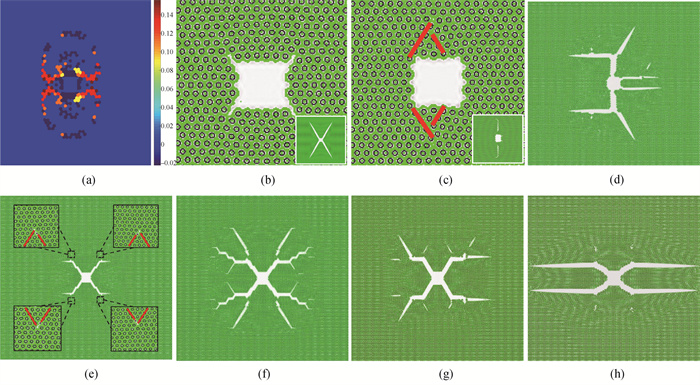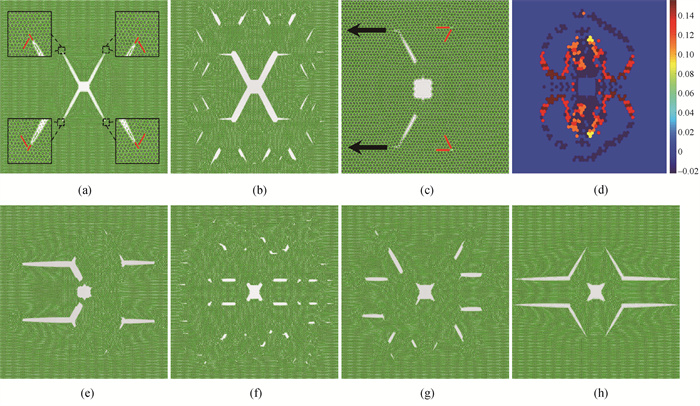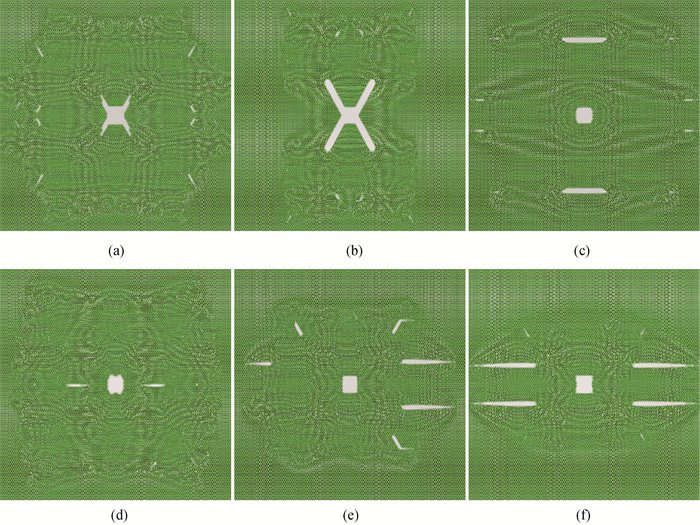Chinese Journal of Computational Physics ›› 2022, Vol. 39 ›› Issue (6): 717-726.DOI: 10.19596/j.cnki.1001-246x.8509
• Research Reports • Previous Articles Next Articles
Jianwei LI1( ), Xuan XIANG1, Jingdong WANG1, Shi HU1, Zheng CHEN2, Yuanhua HE1,*(
), Xuan XIANG1, Jingdong WANG1, Shi HU1, Zheng CHEN2, Yuanhua HE1,*( )
)
Received:2022-01-17
Online:2022-11-25
Published:2023-04-01
Contact:
Yuanhua HE
Jianwei LI, Xuan XIANG, Jingdong WANG, Shi HU, Zheng CHEN, Yuanhua HE. Propagation of Nanoscale Microcrack Under Disturbance Strain at Different Temperatures: Phase-Field-Crystal Model[J]. Chinese Journal of Computational Physics, 2022, 39(6): 717-726.
Add to citation manager EndNote|Ris|BibTeX
URL: http://www.cjcp.org.cn/EN/10.19596/j.cnki.1001-246x.8509

Fig.1 (a) Two-dimensional phase diagram calculated with one-mode approximation; (b) A schematic of the orientation between the crack and the lattice (The blue hexagon box signifies the triangular lattice. The green square box indicates the crack. The dimensions are relatively adjusted to facilitate analysis.); (c) illustration of the initial simulation system(Green and white regions indicate triangular lattice and central crack, respectively.)
| 体系 | 温度r | 频率ω /(10-5Δt-1) | 体系 | 温度r | 频率ω /(10-5Δt-1) | 体系 | 温度r | 频率ω /(10-5Δt-1) | ||
| A1 | -1.0 | 无扰动 | A2 | -0.8 | 无扰动 | A3 | -0.6 | 无扰动 | ||
| B1 | -1.0 | 0.2 | B2 | -0.8 | 0.2 | B3 | -0.6 | 0.2 | ||
| C1 | -1.0 | 2 | C2 | -0.8 | 2 | C3 | -0.6 | 2 | ||
| D1 | -1.0 | 20 | D2 | -0.8 | 20 | D3 | -0.6 | 20 | ||
| E1 | -1.0 | 200 | E2 | -0.8 | 200 | E3 | -0.6 | 200 | ||
| F1 | -1.0 | 2 000 | F2 | -0.8 | 2 000 | F3 | -0.6 | 2 000 |
Table 1 Parameters of the simulation systems
| 体系 | 温度r | 频率ω /(10-5Δt-1) | 体系 | 温度r | 频率ω /(10-5Δt-1) | 体系 | 温度r | 频率ω /(10-5Δt-1) | ||
| A1 | -1.0 | 无扰动 | A2 | -0.8 | 无扰动 | A3 | -0.6 | 无扰动 | ||
| B1 | -1.0 | 0.2 | B2 | -0.8 | 0.2 | B3 | -0.6 | 0.2 | ||
| C1 | -1.0 | 2 | C2 | -0.8 | 2 | C3 | -0.6 | 2 | ||
| D1 | -1.0 | 20 | D2 | -0.8 | 20 | D3 | -0.6 | 20 | ||
| E1 | -1.0 | 200 | E2 | -0.8 | 200 | E3 | -0.6 | 200 | ||
| F1 | -1.0 | 2 000 | F2 | -0.8 | 2 000 | F3 | -0.6 | 2 000 |

Fig.2 (a) Strain distribution pattern of system A1 at n = 27 000; (b) Morphology of system A1 at n = 27 000 (The inset is a local morphology around the central crack at n = 60 000.); (c) Morphology of system C1 at n = 13 000 (The inset is a local morphology around the central crack at n = 40 000.); (d) Morphology of system C1 at n = 57 000; (e) Morphology of system D1 at n = 45 000; (f) Morphology of system D1 at n = 60 000; (g) Morphology of system E1 at n = 60 000; (h) Morphology of system F1 at n = 67 000 (The extra half planes of atoms are indicated by the red lines.)

Fig.3 (a) Morphology of system B2 at n = 38 000 (The red lines indicate extra half planes of atoms.); (b) Morphology of system B2 at n = 55 000; (c) Morphology of system C2 at n = 30 000 (The black arrows indicate crack propagation direction.); (d) Strain distribution pattern of system C2 at n = 18 000; (e) Morphology of system C2 at n = 57 000; (f) Morphology of system D2 at n = 60 000; (g) Morphology of system E2 at n = 60 000; (h) Morphology of system F2 at n = 60 000

Fig.4 (a) Morphology of system A3 at n = 50 000; (b) Morphology of system B3 at n = 43 000; (c) Morphology of system C3 at n = 49 000; (d) Morphology of system D3 at n = 51 000; (e) Morphology of system E3 at n = 50 000; (f) Morphology of system F3 at n = 51 000
| 体系 | 裂纹扩展模式 | 体系 | 裂纹扩展模式 | 体系 | 裂纹扩展模式 | ||
| A1 | 脆性扩展 | A2 | 脆性扩展 | A3 | 韧性扩展 | ||
| B1 | 脆性扩展 | B2 | 韧性扩展 | B3 | 韧性扩展 | ||
| C1 | 韧性扩展 | C2 | 韧性扩展 | C3 | 韧性扩展 | ||
| D1 | 韧性扩展 | D2 | 韧性扩展 | D3 | 韧性扩展 | ||
| E1 | 韧性扩展 | E2 | 韧性扩展 | E3 | 韧性扩展 | ||
| F1 | 韧性扩展 | F2 | 韧性扩展 | F3 | 韧性扩展 |
Table 2 Crack propagation modes of simulated systems
| 体系 | 裂纹扩展模式 | 体系 | 裂纹扩展模式 | 体系 | 裂纹扩展模式 | ||
| A1 | 脆性扩展 | A2 | 脆性扩展 | A3 | 韧性扩展 | ||
| B1 | 脆性扩展 | B2 | 韧性扩展 | B3 | 韧性扩展 | ||
| C1 | 韧性扩展 | C2 | 韧性扩展 | C3 | 韧性扩展 | ||
| D1 | 韧性扩展 | D2 | 韧性扩展 | D3 | 韧性扩展 | ||
| E1 | 韧性扩展 | E2 | 韧性扩展 | E3 | 韧性扩展 | ||
| F1 | 韧性扩展 | F2 | 韧性扩展 | F3 | 韧性扩展 |
| 1 |
DOI |
| 2 |
|
| 3 |
|
| 4 |
|
| 5 |
|
| 6 |
DOI |
| 7 |
|
| 8 |
陈成, 陈铮, 杨涛, 等. 晶体相场模型的研究进展[J]. 材料导报, 2012, 26 (9): 116- 119. 116-119, 141
|
| 9 |
|
| 10 |
|
| 11 |
|
| 12 |
|
| 13 |
吴璐, 潘荣剑, 张伟, 等. 双模晶体相场研究六方四方相变过程晶界和位错演化[J]. 稀有金属材料与工程, 2020, 49 (12): 4103- 4111.
|
| 14 |
DOI |
| 15 |
DOI |
| 16 |
DOI |
| 17 |
赵宇龙, 陈铮, 龙建, 等. 晶体相场法模拟纳米晶材料反霍尔-佩奇效应的微观变形机理[J]. 物理学报, 2013, 62 (11): 118102.
|
| 18 |
马文婧, 柯常波, 周敏波, 等. Sn/Cu互连体系界面和金属间化合物层Kirkendall空洞演化和生长动力学的晶体相场法模拟[J]. 金属学报, 2015, 51 (7): 873- 882.
|
| 19 |
DOI |
| 20 |
卢艳丽, 卢广明, 胡婷婷, 等. 晶体相场法研究Kirkendall效应诱发的相界空洞的形成和演变[J]. 金属学报, 2015, 51 (7): 866- 872.
|
| 21 |
|
| 22 |
郭刘洋, 陈铮, 龙建, 等. 晶体相场法研究应力状态及晶体取向对微裂纹尖端扩展行为的影响[J]. 物理学报, 2015, 64 (17): 178102.
|
| 23 |
|
| 24 |
|
| 25 |
|
| 26 |
|
| 27 |
|
| 28 |
|
| [1] | Hong LI, Lixin ZHANG, Yan REN, Ming GAO, Jingnan LIU. Prediction of Water Temperature of Mixed-flow Closed Cooling Tower Based on BP Neural Network and Grey Correlation Analysis [J]. Chinese Journal of Computational Physics, 2022, 39(1): 53-59. |
| [2] | Zhankang YANG, Yi NIU. Influence of Temperature, Enclosure and Ventilation on Radon Concentration Distribution in a Blind Roadway [J]. Chinese Journal of Computational Physics, 2021, 38(4): 456-464. |
| [3] | CHE Yanjin, QI Yingxia, PAN Shuai, WANG Yuhe, ZHANG Hua. Microscopic Mechanism of Nonlinear Gas Alternating Oscillation in Microchannel Pulse Tube: Molecular Dynamics Study [J]. CHINESE JOURNAL OF COMPUTATIONAL PHYSICS, 2020, 37(5): 571-580. |
| [4] | CHEN Yu, XING Yongming. Effect of Hydrostatic Pressure on Magneto-optical Properties of Al14Mn2P16: A Density Functional Theory Study [J]. CHINESE JOURNAL OF COMPUTATIONAL PHYSICS, 2020, 37(2): 231-239. |
| [5] | SU Geman, CUI Guomin, BAO Zhongkai, XIAO Yuan, CEN Zhenyu. Analysis and Treatment on Structures with Temperature Cross in Heat Exchanger Network [J]. CHINESE JOURNAL OF COMPUTATIONAL PHYSICS, 2020, 37(1): 107-118. |
| [6] | HE Yunlong, LI Ling. Heat Transfer and Phase Change of Laser Irradiated Gold Particle with Scattering Effect [J]. CHINESE JOURNAL OF COMPUTATIONAL PHYSICS, 2019, 36(2): 182-188. |
| [7] | LIU Yongqiang, ZHA Xuejun, WANG Qingsong, YANG Zhen, XIA Qinghao, WU Bin. Influence of Local Heat Source on Thermal Transport in Magnetic Island [J]. CHINESE JOURNAL OF COMPUTATIONAL PHYSICS, 2019, 36(2): 203-210. |
| [8] | ZHANG Kesheng, ZHANG Xiangqun, SHAO Fang, TANG Wenyong. Analysis of Environmental Influencing on Acoustic Relaxation Frequency in Multi-component Excitable Gases [J]. CHINESE JOURNAL OF COMPUTATIONAL PHYSICS, 2019, 36(1): 89-98. |
| [9] | LI Xixia, WANG Li, DAI Haiyan, LI Changyu. Non-Fourier Heat Transfer Based on Extended Separation Variable Method [J]. CHINESE JOURNAL OF COMPUTATIONAL PHYSICS, 2018, 35(6): 685-692. |
| [10] | QI Peng, LIU Huiqing, PANG Zhanxi, LIU Huapu, CHEN Yu. Temperature Distribution Modeling in SAGD Circulation Phase [J]. CHINESE JOURNAL OF COMPUTATIONAL PHYSICS, 2018, 35(1): 64-70. |
| [11] | LI Zhenhuan, SUN Haifeng, XIA Xinlin, LI Yang. Decoupling Method for Transient Thermal Status of Low Supersonic Aircrafts [J]. CHINESE JOURNAL OF COMPUTATIONAL PHYSICS, 2016, 33(6): 681-690. |
| [12] | DAI Zihuan, WU Jiming, DING Ning. Artificial Viscosity Splitting Strategy in Lagrangian Algorithm for Two-dimensional Three-temperature Radiation Magnetohydrodynamics [J]. CHINESE JOURNAL OF COMPUTATIONAL PHYSICS, 2015, 32(4): 379-385. |
| [13] | WANG Ran, AN Liansuo, SHEN Guoqing, ZHANG Shiping. Three-Dimensional Temperature Field Reconstruction with Acoustics Based on Regularized SVD Algorithm [J]. CHINESE JOURNAL OF COMPUTATIONAL PHYSICS, 2015, 32(2): 195-201. |
| [14] | WANG Hongliang, TIAN Zhou, GUO Yonghui. Effect of Particles-piled on Energy Attenuation at High Temperature and High Pressure [J]. CHINESE JOURNAL OF COMPUTATIONAL PHYSICS, 2014, 31(6): 706-712. |
| [15] | LI Bo, NING Bo, SU Haiyang, LIU Hong, WEI Yunsheng. A Calculation Method for Temperature and Pressure Distribution in Water Production Gas Wellbores [J]. CHINESE JOURNAL OF COMPUTATIONAL PHYSICS, 2014, 31(5): 573-580. |
| Viewed | ||||||
|
Full text |
|
|||||
|
Abstract |
|
|||||
Copyright © Chinese Journal of Computational Physics
E-mail: jswl@iapcm.ac.cn
Supported by Beijing Magtech Co., Ltd.
